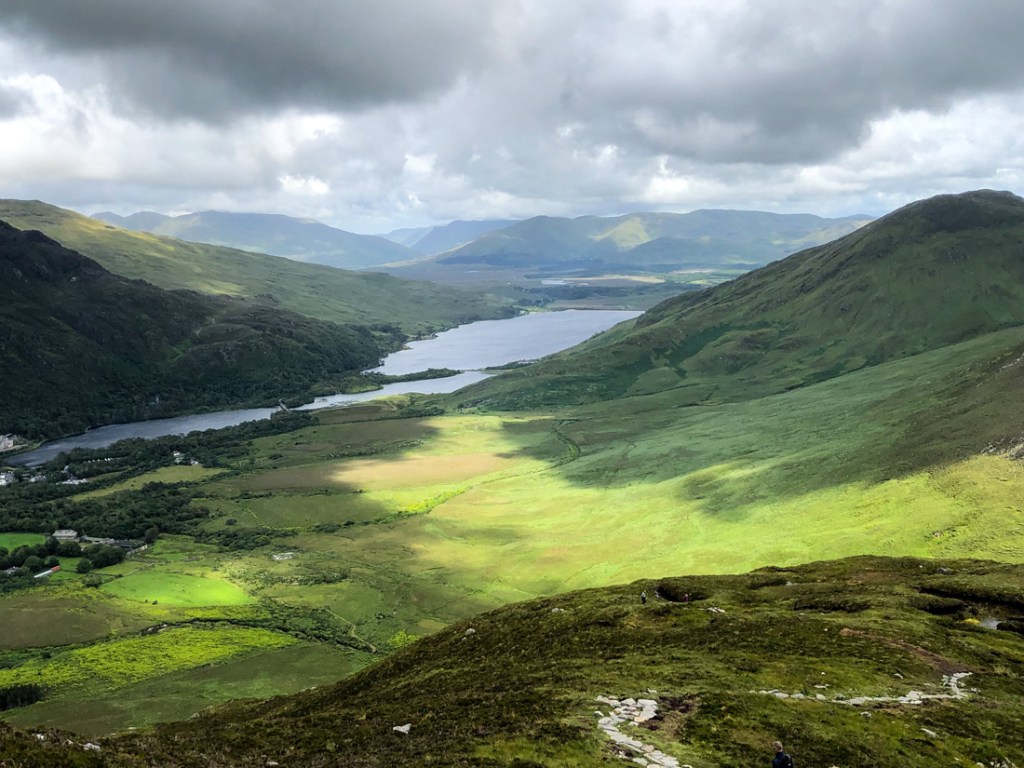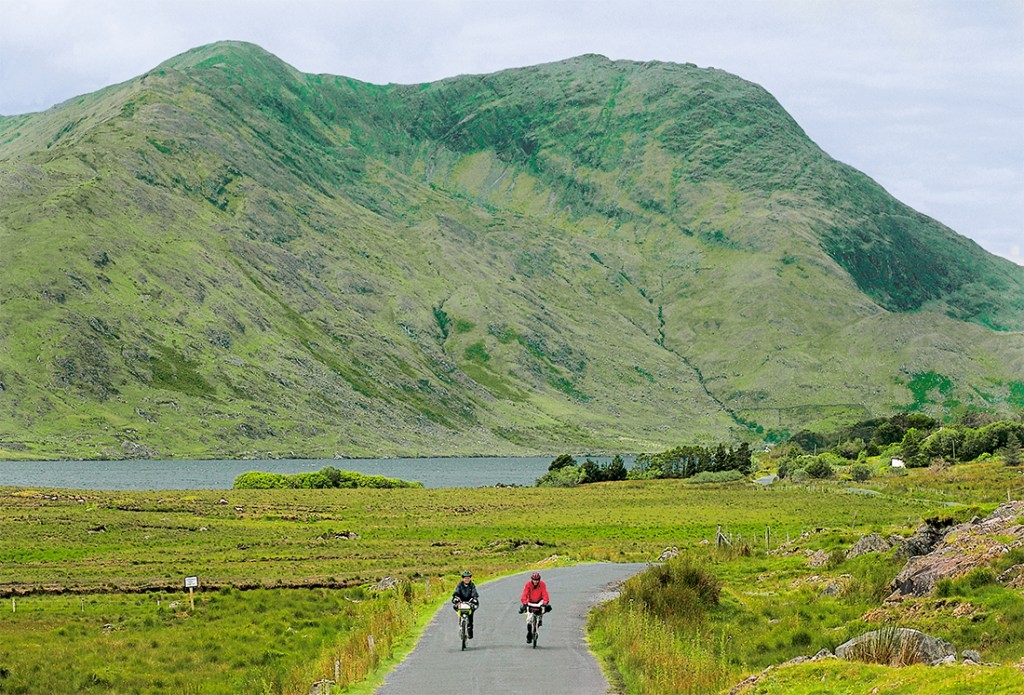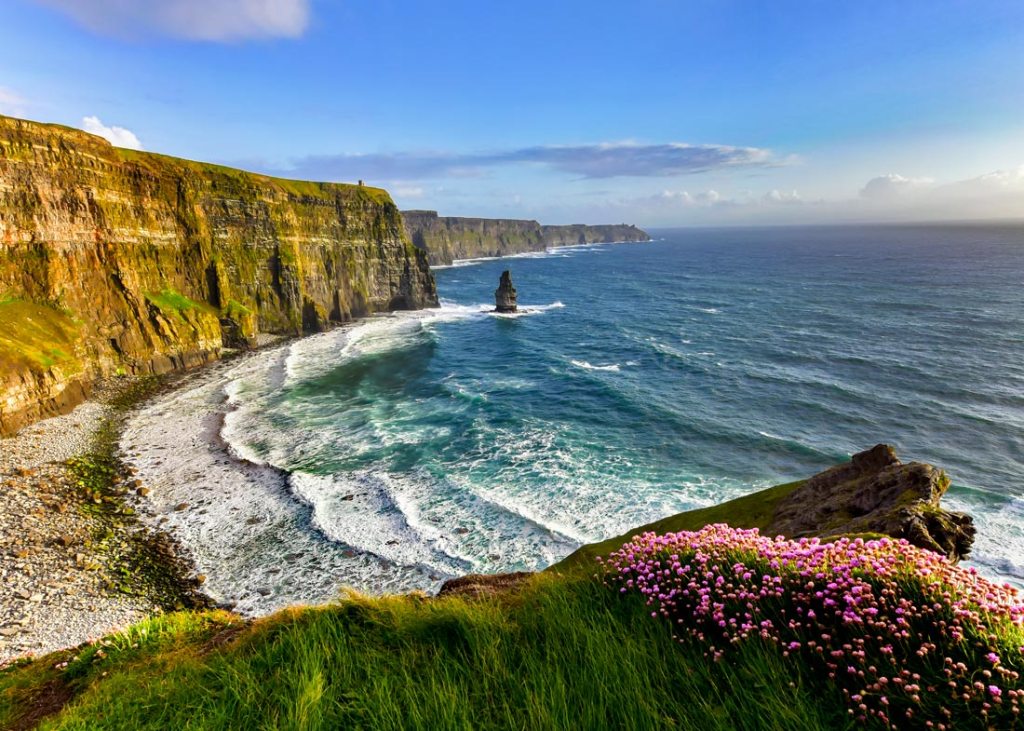With nearly 40 percent of Ireland’s approximately five-million residents living in the Dublin metropolitan area, it’s super easy to get off the beaten track in rural, uncrowded hinterlands and coastal areas beyond the city. Surfing, cycling, hiking, rock climbing and trail running are just a few of the activities you’ll find in the country, and we’ve called out a few of our favorites to help you start planning your trip to the Emerald Isle.
1. Hiking and Trail Running

The view along Ireland’s Atlantic coast.
Modern trails are often based on historic walking routes that crisscross the country. The trails cover an impressive variety of terrain and offer an immersive experience that you can take in at your own speed—whether you’re running or hiking. Most importantly, traveling on foot might just be the best way to get a genuine glimpse of Ireland’s beautifully enchanting and haunted heart.
The Wicklow Way
Counties Dublin, Wicklow, Carlow
This famed 80-mile trail begins just five miles from Dublin’s bustling city center in Marlay Park and winds up into the nearby Wicklow Mountains (colloquially referred to as the Dublin Mountains). The route originally connected small rural communities and today is a gorgeous, undulating path through forests, upland bogs, open mountainsides, lakes, waterfalls, working farms and small villages. Be sure to budget some extra time to explore Glendalough’s extensive 6th-century monastic ruins.
Howth
County Dublin
This cliffside trail network above the Irish Sea is the perfect introduction to Ireland’s stunning, raw and rugged shores despite being just about 5 miles from Dublin’s city center. Stop by the nearby Summit Inn for a post-hike pint.
Cliffs of Moher
County Clare
Cliffs of Moher, where miles of sheer cliff drop into the Atlantic in an instant, showcase western Ireland in all its glory. In fact, the cliffs—and the Burren, an adjacent, glacially smoothed limestone landscape—were designated a UNESCO geopark in 2015, which promotes conservation, education and sustainable tourism practices. The main trail extends along the clifftop for about 11 miles, including some exposed sections that are not for the faint of heart. Reward your fortitude with a Guinness and fresh seafood in Doolin, a charming seaside village considered the heart of Ireland’s lively traditional music scene.
Killarney National Park
County Kerry
Ireland’s first national park, Killarney was created in 1932 and designated a UNESCO biosphere reserve in 1982. Running or hiking the forested hills, past lakes and waterfalls, may be the best way to experience the 26,000-acre park, home to the largest native forest in the Ireland. Though the Emerald Isle is less biodiverse than much of Europe, the country is working to restore and preserve the native ecology by protecting the island’s sole remaining herd of indigenous red deer, which have inhabited Ireland since Neolithic times.
2. Cycling
Road Biking

Cyclists navigate the green, pastoral landscape of the Irish countryside.
You’ll find plenty of bike lanes, a bike-share program and a plethora of resources for local and visiting cyclists in Dublin, and outside the capital, the roads are winding, narrow and beautiful, meaning exploring the entire country by bike is not only feasible, it’s one of the best ways to experience the island. If you don’t happen to have time to cover the whole country, cycling a portion of Atlantic coast is a great way to pack in plenty of sightseeing, fresh seafood, castles and cliffs.
Mountain Biking
Although there are mountain biking trails and clubs all over the Emerald Isle, the most popular and developed trails are closer to the populous Dublin metro area. Ticknock and Ballinastoe are popular trail centers less than 30 minutes from the city, or head 45 minutes south to ride the gravity-fed trails at Glencullen Adventure Park. If you’re looking to get away from the capital, Bike Park Ireland in Tipperary is a fun getaway with varying levels of trails and on-site camping.
3. Watersports

The Cliffs of Moher.
Though the water may be cold, the quality of Ireland’s winds, waves and inland waterways is on par with the world’s most-coveted watersports destinations.
Surfing
The action is on the Atlantic side. County Sligo boasts a variety of surf beaches, County Donegal’s Tullan Strand sports an expert break at one end of the beach and gentles waves on the other, and Lahinch Strand in County Clare is considered by many to be the epicenter of Irish surf culture. But if you want to see the pros in action, head to Aileen, a reef break under the Cliff of Moher where waves can reach as high as 40 feet. The ancient Irish called the break Aill na Searrach, or Foal’s Leap, for the seven Celtic gods who turned themselves into horses and charged through the fearsome wave into the afterlife, livid because Christianity had come to the island.
Kiteboarding
Dublin Bay, just minutes by bike or foot from the city center, is a kiter’s dream. Kiting schools have popped up on either side of the port. To the north, Dollymount Strand (Bull Island) is probably Ireland’s most famous kite surf spot, but as the sport’s popularity grows, it can get crowded. To the south, Poolbeg is the less scenic of the two spots but has a huge tidal range for flat shallow water. A great third option is to head a few hours west of the metro area to the Atlantic coast: Achill Island in County Mayo is known for stellar kiting, with conditions for all levels.
Paddle
You can SUP right up the center of Dublin on the storied River Liffey, a tidal waterway that flows from high in the Wicklow Mountains through into the Irish Sea. Or explore the countryside by kayaking Ireland’s inland canals, which are being transformed from disused barge transport routes into a nation-wide system of paddling trails called Waterways Ireland.
